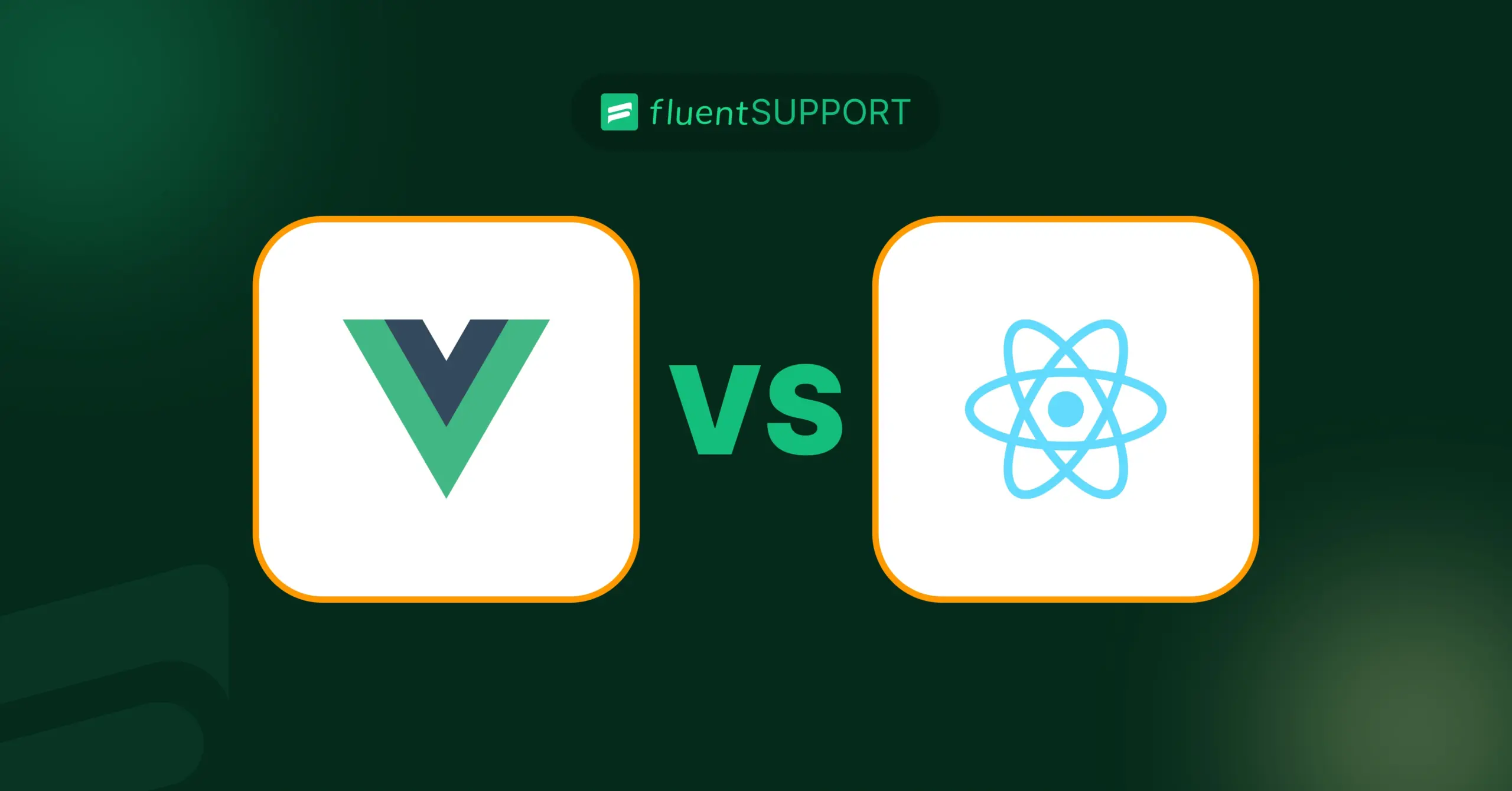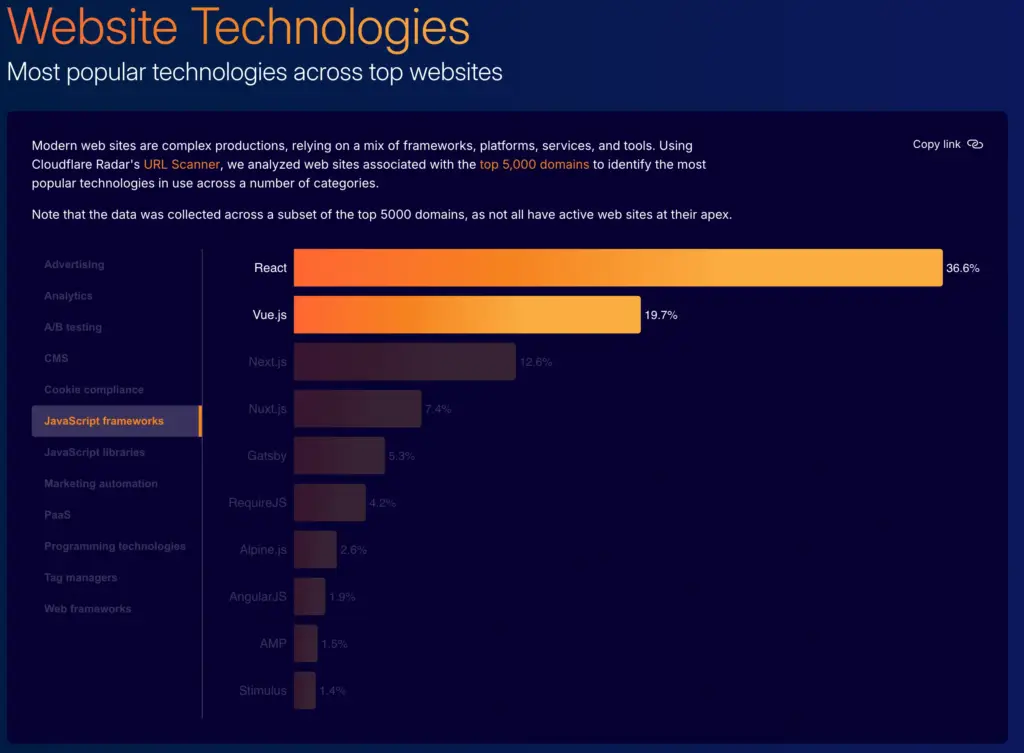
Vue.js VS React.js: Which One Should You Use? [2025 Edition]
By Md. Ariful Basher
December 31, 2024
Last Modified: January 10, 2025
Choosing the right JavaScript framework can make or break your development project. Vue.js and React are two of the most popular frameworks available, but deciding which one to use can be a challenge because they both have some significant pros.
Considering their strengths, the choice often depends on the specifics of your project. So, let’s dive into a detailed comparison of Vue.js and React.js to help you make an informed decision.
What is Vue.js?
Vue.js is a progressive JavaScript framework designed for building user interfaces. It’s lightweight, fairly easy to learn, and highly flexible in terms of system development. One of the standout features of Vue.js is its two-way data binding, which automatically syncs data between the model and the view. Which comes handy for larger projects.
Its component-based architecture makes it easier to build reusable and maintainable components. The reactive structure updates the DOM (Document Object Model) automatically whenever the underlying data changes.
Vue.js emphasizes simplicity, making it an excellent choice for both beginners and experienced developers. It is straightforward enough to be set up for even small projects.
What is React.js?
React.js, developed by Facebook, is a JavaScript library for building systems or web user interfaces. Unlike Vue.js, which is a full framework, React focuses mainly on the “View” in the Model-View-Controller (MVC) pattern. It’s powerful and scalable, and it’s widely adopted in large-scale applications.
React introduces the virtual DOM, which optimizes updates to the real DOM, making applications faster and more efficient. Its component-based architecture encourages reusability and modular code, just like Vue.
React also relies on a one-way data flow, which ensures better control and predictability of data. With its rich ecosystem, React offers numerous libraries and tools for developers to meet a wide range of needs.
Vue.js vs React.js: a comparison
When it comes to ease of learning, Vue.js is often seen as a more beginner-friendly framework than React.js. It has a gentle learning curve and an intuitive syntax that’s ideal for developers new to JavaScript and frameworks in general.
In contrast, React has a bit harder learning curve, primarily due to the use of JSX (JavaScript XML) and the need to understand concepts like state management.
Both Vue.js and React.js deliver excellent performance, though React’s Virtual DOM provides a slight edge, particularly in large-scale applications.
In terms of flexibility, Vue.js is highly adaptable to different project sizes and requirements, offering built-in solutions for routing and state management.
React, on the other hand, relies heavily on third-party libraries. This reliance provides more freedom but also requires extra effort to set up and maintain (like, feature updates).
The community and ecosystem of these frameworks differ significantly. Vue.js has a growing community, especially in Asia and Europe
React has a massive global community and the backing of Meta. This ensures robust support and regular updates with the help of a large community.

Source: The Cloudflare Radar 2024 Year in Review
Comparison of code base
The structure of the code base in Vue.js is highly intuitive and straightforward, making it an excellent choice for developers who prefer simplicity. Vue.js uses an HTML-based template syntax, which is familiar and easy to grasp.
A basic Vue.js component typically includes three sections: a template for defining the UI, a script for logic, and a style section for CSS. This separation ensures simplicity, to-the-point clarity, and maintainability.
React.js, on the other hand, uses JSX, which allows developers to write HTML directly within JavaScript. This approach provides more power and flexibility but can be initially confusing for new developers.
React components are purely JavaScript functions or classes that return a UI description. While this encourages a more programmatic approach, it often results in a bit of a difficult learning process for those unfamiliar with mixing markups and logics in one place.
For instance, in Vue.js, a simple counter component might look like this:
<template>
<div>
<p>{{ count }}</p>
<button @click="increment">Increment</button>
</div>
</template>
<script>
export default {
data() {
return {
count: 0
};
},
methods: {
increment() {
this.count++;
}
}
};
</script> In React, the same functionality would be written like this:
import React, { useState } from 'react';
function Counter() {
const [count, setCount] = useState(0);
return (
<div>
<p>{count}</p>
<button onClick={() => setCount(count + 1)}>Increment</button>
</div>
);
}
export default Counter; As shown, Vue.js maintains a clear distinction between HTML, CSS, and JavaScript, while React.js combines them using JSX. Both approaches have their pros and cons, depending on the developer’s preference and project requirements.
Community and ecosystem
React benefits from a larger developer ecosystem with more templates, tools, and resources. This extensive ecosystem provides extensive flexibility.
In contrast, Vue.js offers a more cohesive and streamlined ecosystem, with official support for companion libraries like Vue Router and Vuex. This makes Vue.js particularly appealing to those who prefer a more opinionated structure.
Scalability
React.js is often the preferred choice for large-scale applications due to its flexibility and extensive ecosystem. It provides the tools and resources needed to build complex, scalable applications.
Vue.js, while also scalable, shines in projects where its opinionated structure and built-in solutions can simplify development.
Performance
Both frameworks deliver efficient performance, but developers often find Vue.js faster and more straightforward in smaller projects, leading to quicker development times.
React’s Virtual DOM, however, gives it an edge in handling large-scale applications with frequent updates.
Documentation and support
Both frameworks boast excellent documentation and community support. React.js has a larger global community and is backed by Facebook, ensuring robust resources and updates.
Vue.js, on the other hand, is praised for its comprehensive and user-friendly documentation, making it a favorite for developers seeking clear and concise guidance.
When to choose Vue.js?
Vue.js is a great choice if you are a beginner or looking for a simple framework to start with. It’s ideal for small to medium-sized projects. For developers who prefer a framework with built-in solutions and minimal configuration, this could be a great choice.
When to choose React.js?
React is better suited for large-scale applications. If you’re comfortable with JavaScript and mix and match with advanced concepts, React’s ecosystem and extensive customization options will give you the flexibility you need for complex projects.
Vue.js vs React.js comparison table
Here is the simple sumup of these two great JavaScript frameworks.
| Feature | Vue.js | React.js |
|---|---|---|
| Origin | Developed by Evan You, initially released in 2014 | Developed by Facebook, initially released in 2013 |
| Architecture | MVVM (Model-View-ViewModel) | Library focused on the View in MVC |
| Framework Type | Progressive Framework | UI Library |
| Learning Curve | Create React App, React DevTools | Moderate, often needs understanding of JS ecosystem |
| Syntax | Single File Components (HTML, JS, CSS) | JSX (JavaScript XML) |
| State Management | Vuex | Redux, MobX, Context API |
| Community Support | Strong and growing, great documentation | Very large, established, backed by Facebook |
| Performance | High performance, fast rendering | Very high performance, virtual DOM |
| Flexibility | Flexible, integrates well with other projects | High, can be integrated with other libraries |
| Popularity | Gaining popularity | Extremely popular |
| Tooling | Vue CLI, Vue Devtools | Create React App, React Devtools |
| Mobile Development | NativeScript, Quasar | React Native |
| Data Binding | Two-way data binding | One-way data binding |
Conclusion
Both Vue.js and React.js are powerful tools for modern web development, and the best choice depends on your project’s needs and your team’s expertise.
Evaluate your requirements, team skill set, and project scope carefully, and you’ll make the right decision. Remember, the goal is to choose the right tool that helps you build better, faster, and smarter. It’s not a showoff war of Vue.js vs React.
Start off with a powerful ticketing system that delivers smooth collaboration right out of the box.












Leave a Reply